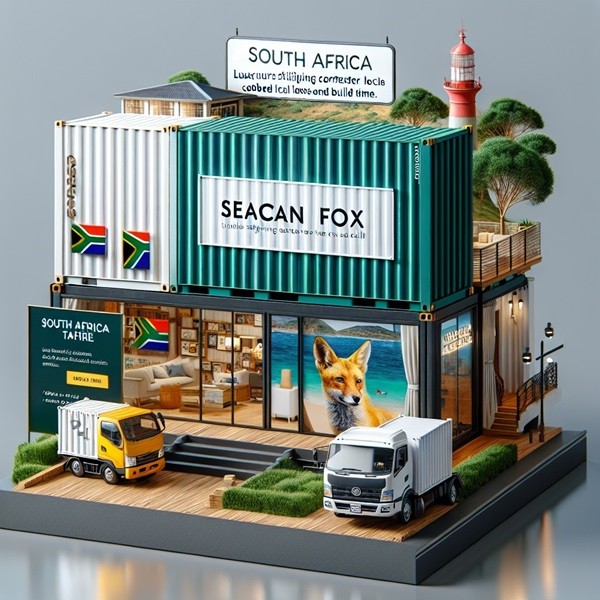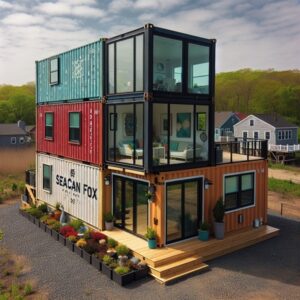
Key Takeaways
- Shipping container homes are subject to the same building regulations as traditional brick-and-mortar homes in South Africa.
- The cost of converting a shipping container into a home varies, but expect to pay for the container, alterations, finishing, and potential hidden expenses.
- Building a container home can be faster than traditional construction, but the timeline depends on the complexity of your project.
- Approval from local councils is necessary and involves a step-by-step process including zoning, permits, and compliance with building codes.
- Container homes offer environmental benefits and can be customized to suit your unique style and needs.
Understanding South Africa Shipping Container Homes
Imagine turning a simple shipping container into a cozy, sustainable home. It’s an exciting concept, and it’s gaining momentum right here in South Africa. But before you dive into this innovative housing trend, there are some critical aspects you need to understand.
My Favorite Container Homes Resource
I compared the top 3 Container Home Guides
to discover the ultimate resource!
See my top recommendation here
Let’s start with the basics. Shipping container homes are made from steel containers that were originally used for transporting goods. These containers are sturdy, readily available, and can be transformed into beautiful homes with the right vision and planning. They offer a unique blend of durability, affordability, and sustainability that’s hard to match with conventional building materials.
Laws Governing Container Homes in South Africa
Just like any home, a container home needs to comply with local building regulations. In South Africa, this means your container home must meet the National Building Regulations and Building Standards Act. These rules ensure that buildings are safe and environmentally responsible. Therefore, it’s essential to familiarize yourself with these regulations or work with an architect who can guide you through the process.
Estimating the Cost of Your Container Home Project
When budgeting for your container home, consider the following:
- The cost of the container itself, which can range from a few thousand rands for a used one to tens of thousands for a new one.
- Alterations like cutting windows, doors, and
can add significantly to the cost. - Interior and exterior finishes to make your home comfortable and aesthetically pleasing.
- Hidden costs such as delivery fees, site preparation, and utility connections.
Timeline: From Planning to Living in Your Container Home
The timeline for

Navigating South African Laws for Container Homes
Now, let’s delve into the nitty-gritty of the legal side. The first step is understanding the zoning laws in your area. Zoning dictates what types of structures can be built and where. Next, you’ll need to obtain the necessary permits, which might include building, electrical, and plumbing permits.
Building codes and standards compliance is next. Your container home will need to be structurally sound, have proper insulation, and meet fire safety regulations. Remember, while shipping containers are made of steel, which is fire-resistant, the materials you use for insulation and interior finishes must also comply with fire safety standards.
Securing council approval is a step-by-step process:
- Submit your building plans for approval.
- Ensure your plans comply with zoning regulations.
- Pass inspections during the construction process.
Once you’ve cleared these hurdles, you’re on your way to building your dream container home!
Design Phase: Blueprint to Reality
Before the physical work begins, your dream container home starts as a blueprint. This design phase is where creativity meets practicality. You’ll decide where to place windows for the best natural light, how to layout rooms for flow and functionality, and choose materials that align with your aesthetic and budget. It’s important to involve a structural engineer and an architect during this phase to ensure your designs are both feasible and compliant with building regulations.
Site Preparation and Foundation Laying
Once your design is council-approved, it’s time to prepare your site. This involves clearing the land, leveling the ground, and possibly grading it for drainage. Your container home will need a solid foundation, just like any other house. This could be a simple concrete slab or more complex pier or strip foundations, depending on your land and design.
It’s crucial to get the foundation right because it affects the integrity and longevity of your container home. During this stage, you’ll likely encounter inspections from local authorities to ensure everything is up to code.
- Clear and level the building site.
- Choose the right foundation for your terrain and container design.
- Have the foundation inspected to ensure it complies with building regulations.
With a solid foundation in place, you’re ready for the exciting part—seeing your container transformed into a home.
Modification Work: Cutting, Framing, and Insulating
The real transformation begins with modification work. Shipping containers are essentially blank canvases, and now it’s time to cut out spaces for doors, windows, and maybe even a skylight. Next comes framing—creating an internal skeleton that will support walls, ceilings, and any additional fixtures.
Insulation is critical. It’s not just about keeping warm in the winter or cool in the summer; it’s also about preventing condensation, which can lead to rust and mold. You’ll need to choose insulation that works well with the metal structure of a container and complies with energy efficiency regulations.
Utility Setup: Electricity, Plumbing, and Internet
- Work with certified professionals to install electrical wiring and plumbing.
- Plan for internet and cable wiring—modern homes need to be well-connected.
- Consider renewable energy sources, like solar panels, for a sustainable home.
Utilities are what make a house livable. For electricity, you’ll need a certified electrician to wire your home safely. Plumbing is another job for the pros—getting water in and waste out without leaks or freezes. And don’t forget about the internet and cable. These modern necessities require planning to integrate them seamlessly into your home’s design.
As you’re setting up utilities, think about sustainability. Solar panels, rainwater harvesting systems, and other green technologies can make your container home even more eco-friendly.
With the walls framed, utilities in place, and insulation keeping the elements at bay, your container is starting to look like a home.
Final Touches: Moving In
The final touches are what turn a construction project into your personal sanctuary. This is when you install drywall, paint walls, lay flooring, and put in the fixtures and fittings that reflect your style. It’s also when you’ll do a final walkthrough to make sure everything is perfect.
Once you’ve passed the final inspections and received your certificate of occupancy, it’s time to move in and enjoy the fruits of your labor. You’ve turned a steel box into a warm and inviting home.
Summary of Shipping Container Homes Features and Costs in South Africa
| Feature | Description | Cost | Reference |
|---|---|---|---|
| Legal Status | Container homes are legal in South Africa but must comply with local building regulations and be council-approved. | – | Briefly.co.za |
| Build Time | Container homes can be built much faster than traditional homes. A 180m2 home can be completed in less than 3 months. | – | Container Home |
| Durability | Container homes are made of high-quality steel, making them very durable and able to withstand extreme weather conditions. | – | Container Homes Cape Town |
| Cost | Container homes are generally cheaper than traditional homes. A single bedroom 12-metre container with basic finishes starts at R225,000 excluding VAT. A 2-bedroom unit starts from R242,000 excluding VAT. |
R225,000 – R242,000 excluding VAT | CBN |
References:
Maximizing the Benefits of Shipping Container Homes
Shipping container homes aren’t just a passing fad; they offer a unique set of benefits that traditional homes can’t match. They are often more affordable and faster to build, and they have a smaller environmental footprint.
Environmental Advantages and Sustainability
One of the most compelling reasons to choose a shipping container home is its environmental benefits. These homes repurpose steel containers that might otherwise sit unused, reducing waste. They also require fewer building materials, which minimizes the environmental impact of construction.
Customization: Making Your Home Uniquely Yours
Your container home is a reflection of your personality and style. Whether you want a minimalist abode or a fully decked-out dwelling, the customization options are nearly limitless. You can:
Choose eco-friendly materials and add-ons like solar panels and green roofs.
Design an open-concept living space or cozy, compartmentalized rooms.
Include large glass doors and windows to blend indoor and outdoor living.
- Select colors and finishes that suit your taste and lifestyle.
- Integrate smart home technology for added convenience and efficiency.
- Plan your landscaping to complement your container home’s aesthetics.
With thoughtful planning, your container home can be as unique as you are.
Maintaining Your Container Home for Longevity
Like any home, a container home requires maintenance to keep it in top condition. Regularly check for and address rust, ensure your insulation remains effective, and keep an eye on the seals around windows and doors. Proper maintenance will ensure your home remains comfortable, safe, and beautiful for years to come.
Looking Ahead: The Future of Container Homes in SA
Container homes are not just a temporary trend; they are a viable solution to housing challenges in South Africa and beyond. As we look to the future, the potential for growth in this sector is significant. With a growing population and an increasing need for affordable, sustainable housing, container homes offer a promising alternative to traditional construction methods.
Technological advancements and creative design innovations continue to push the boundaries of what’s possible with container homes. From simple, single-container studios to expansive multi-container family homes, the possibilities are as limitless as the imagination of those who build them.
Technological Advances and New Materials
As technology evolves, so too does the potential for container home construction. Cutting-edge insulation materials, smart home technology, and renewable energy systems are becoming more accessible and affordable. These advancements not only improve the livability of container homes but also their environmental footprint.
Growing Trends in Modular Living
Modular living is gaining traction globally, and South Africa is no exception. The trend towards downsizing and living more sustainably is driving interest in alternative housing. Container homes, with their modular nature, are at the forefront of this movement, offering flexibility and customization that traditional homes simply cannot match.
Government Incentives and Housing Solutions
The South African government recognizes the need for innovative housing solutions. In the future, we may see more incentives for those who choose to build container homes, such as grants, subsidies, or expedited permit processes. Such support would not only benefit individual homeowners but also contribute to solving the broader housing crisis in the country.
Frequently Asked Questions

Do I Need a Permit to Build a Container Home in South Africa?
Yes, you need a permit to build a container home in South Africa. The process involves submitting detailed plans to your local municipality and ensuring your project complies with the National Building Regulations. It’s a necessary step to ensure the safety and legality of your new home.
How Much Does It Typically Cost to Build a Container Home in South Africa?
The cost of building a container home in South Africa can vary widely. A basic, no-frills conversion might start at around R100,000, while a more luxurious, fully-fitted home could run into the millions. Factors such as the size of the home, the cost of the land, and the finishes you choose will all influence the final price.
What is the Average Build Time for a Container Home in South Africa?
The build time for a container home in South Africa can range from a few months to a year, depending on the complexity of the design and the efficiency of your construction team. The simplicity of container homes often allows for a quicker build time compared to traditional homes.
Can Container Homes Withstand Extreme Weather?
Container homes are made from steel, which is a robust and durable material. With proper design and insulation, they can withstand extreme weather conditions, including heavy rains, high winds, and even earthquakes. It’s all about the quality of the construction and the materials used.
- Ensure the container is properly insulated and sealed.
- Install high-quality windows and doors to withstand the elements.
- Choose a location that minimizes exposure to extreme weather.
Are There Any Financing Options for Container Homes in South Africa?
Financing options for container homes in South Africa are still emerging. Traditional mortgage products may not always apply, but some financial institutions are beginning to recognize the legitimacy of container homes. Alternative financing options, like personal loans or construction loans, might be viable paths to explore.





